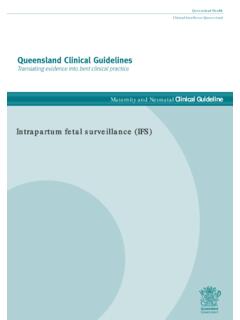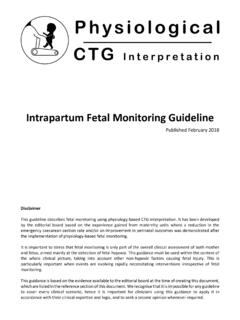Transcription of Fetal Monitoring and Umbilical Cord Gases
1 Fetal Monitoring and Umbilical Cord Gases : What s the Secret?Patricia A. Heale, DNP, RNC-OB, C-EFM The learner will be able to describe the process for Umbilical cord blood collection. define the normal acid-base parameters of Umbilical cord blood Gases . discuss the clinical value of determining acid-base Low levels of oxygen in the tissuesWhat is Hypoxia? Acidemia state of low blood pH Acidosis the process of becoming acidemicAcidemia & Acidosis Birth asphyxiaoccurs when a baby doesn't receive enough oxygen before, during or just after birth Hypoxia, hypercapnia, and respiratory and/or metabolic acidemiaWhat is Asphyxia?
2 ACOG reports that Fetal asphyxia occurs in 25 of 1000 live births and 15% of those are moderate to severeFetal Asphyxia Occurrence Ultrasound Biophysical Profile (BPP) Doppler studies Electronic Fetal Monitor Umbilical Cord Blood AnalysisAssessing Fetal Well-Being ..a valuable but imperfect tool. (Clark, et al. 2017, p. 163)Electronic Fetal Monitor Decrease incidence of cerebral palsy and intrapartum stillbirthExpected Outcomes No difference # intrapartum stillbirth (one in 300) There were no differences in the incidence of CP Neonatal seizures decreased with EFM Continuous Monitoring is associated with a significant increase in C/S and operative birthsActual OutcomesYearCD% of EFM Unrealistically high expectations Lack of standardization of FHR definitions until 1997/2008 Poor reliability for FHR interpretation Failure to show the validity of FHR Monitoring in detecting Fetal asphyxiaBenefit Not Realized.
3 Of infants born with metabolic acidemia, only approximately one-half could be identified potentially and have delivery expedited, even under ideal circumstances. (Clark, et al, 2017, p. 163)Electronic Fetal MonitorTotal Deceleration AreaTotal Deceleration Area(Cahill, et al., 2012)Category I StripCategory III StripCategory III Strip Pareret al. (2006) reported that only 24% of fetuses with Category III strips have metabolic acidemia Category III Strips Hypoxic (lack of oxygen) Ischemic (restricting blood flow) Encephalopathy (affecting the brain) Abnormalities during the last hour of Fetal heart rate Monitoring are poorly predictive of neonatal HIEH ypoxic Ischemic Encephalopathy Hypoxic-ischemic encephalopathy is associated with significant increases in electronic Fetal Monitoring abnormalities, but the predictive ability to identify these conditions is low.
4 Larma, et al., 2007 Hypoxic Ischemic Encephalopathy Specificity of Percent of healthy pts appearing healthy Sensitivity of Percent of unhealthy pts appearing unhealthyLarma, et al., 2007 EFM Predicting Acidosis UCG s are an important parameter in the decision for brain cooling Neonataltherapeutic hypothermia has been shown to help reduce significant braindamage in infants who suffered from lack of oxygen during labor/birthIs Acidemia Important? In 1958, James, et the possibility of interpreting Umbilical cord blood gasesHistory of UCBG Intrapartum Event =/? Adverse Outcome All Non-elective cesareans deliveries 5-minute Apgar 3 Abnormal Fetal Heart Rate Tracing Severe IUGR Intrapartum Fever Maternal Thyroid Disease Multiple GestationACOG Committee Opinion Cord blood analysis is the most objective way of assessing the Fetal condition at birth Allows for differentiation of respiratory and metabolic acidemiaClinical Relevance pH > pO2 > 20mmHg pCO2 < 60mmHg Bicarbonate >22mEq/L Base Excess >-12mEq/L Base Deficit <12mEq/L (Adapted from AWHONN FHMPP, 2016)
5 Normal Cord Gas Values Fetal neurologic injury does not occur without significant metabolic acidemia pH < , 2010 Fetal Injury Potential for Hydrogen (H+) Increasing H+, decreasing pH Decreasing H+, increasing pH Fetal Normal = > ACOG recommends= < for severe acidemiapH The amount of dissolved oxygen in the blood Normal Umbilical gas values >20mmHg pO2 Dissolved carbon dioxide in the blood Normal Umbilical gas value <60mmHg Umbilical vein has lower pCO2 Umbilical artery has higher pCO2pCO2 Buffering systems Circulating acids are neutralized Bicarbonate (HCO3) is the largest buffering systemBicarbonate The base excessis definedas the amount of H+ ions that would be required to return the pH of the blood to expressed as a -number Indirect measurement of anaerobic metabolismBase Excess If you had a high H+ content in the blood (metabolic acidemia)
6 It would take a very low amount to return to Excess Maternal oxygenation is compromised Maternal cardiac disease Reduced perfusion of the placenta Preeclampsia Delivery of oxygenated blood from the placenta to the fetus is impeded Abruption, cord entanglementPoor Oxygenation CO2 accumulates pCO2 >60mmHg pH falls Develops quickly, clears quickly Primary ApneaRespiratory Acidemia Delayed Cord Clamping (DCC) Reperfusion of the peripheral tissues causes CO2 to be released and can be detected in the Umbilical artery Decreased pH Increased CO2 Hidden Acidemia Absence of available O2the cells will shift into anaerobicmetabolism which produces lactic acid as a byproduct When lactic acid exceeds buffering capacity the result is metabolic acidemia Secondary apneaMetabolic AcidemiaAerobic RespirationMetabolic PotO2 GlucoseCO2H2O38 ATP (Energy)Heat (417kcal)Anaerobic RespirationMetabolicPotGlucose onlyLactic acid2 ATP (Energy)Heat (32kcal)
7 Both necessary to ensure the biological validity of the samples obtainedArterial or Venous or Both pH of the vein will always be higher than the artery ( ) pCO2 of the vein will always be lower than the arteryArterial vs. Venous Sample Umbilical cord arterial pH is a measure of the Fetal condition at birth Umbilical cord venous pH is a measure of maternal acid-base status and the condition of the placentaArterial vs. Venous Sample Respiratory acidemia CO2 greater than 60mmHg Metabolic acidemia Bicarbonate <22mEq/L Base Excess <-12mEq/L Mixed All of the aboveRespiratory, Metabolic or Excess-4-2pH Practice A wide difference in values is often due to obstructed O2 delivery A small difference is most likely caused by impairment of maternal perfusion of the placentaUA/UV DifferencesVariable UA-UV DifferenceLate DecelerationsSmall UA-UV Excess-22-20 Double Clamped Cord SegmentUmbilical Artery SamplingUmbilical ArteryUmbilical VeinNo Air in Sample Clamped cord good for 60 minutes at room temperature Stable in a plastic syringe for 30 minutes prior to sampling Transport at room temperatureWait Time & Transport















